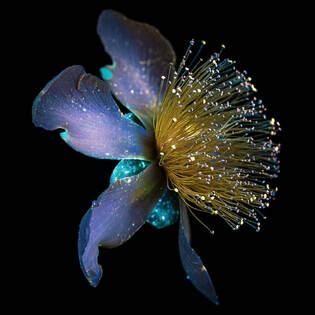
One of the interesting wildflowers I've encountered has the interesting name of Handsome Harry (Rhexia virginica). It is a species of Meadow beauties native to eastern North America.
The first time I saw Handsome Harry, the gorgeous flower took my breath away. I mean that both literally and figuratively!
A ditch filled with lots of briars blocked the path between me and Harry, yet I was determined to get a closer look. It took quite a bit of effort to navigate the thorny obstacles, but it was worth the effort and exercise.
The contrast between the single flower and the rest of the greenery couldn't be captured in the photograph. The lavender blossoms added nature's unique artistic touch to the scene. And it was priceless!
Since then, I've come across many other meadow beauties, but that first one will always be the most beautiful of them all.
An interesting tidbit of information: not all insects can pollinate meadow beauties. It relies on native bees, including bumble bees for buzz pollination. This specialized skill uses rapid vibrations of the bee's wings to detach pollen from the flower's anthers.
Video of bumble bee buzz pollinating a meadow beauty. If you listen closely, you can hear the higher pitched buzz.

According to the-scientist.com, plants produce odors that are picked up through the sensilla on an insect's antennae. Most flower odors have evolved specifically to attract insects.
But that's not all. A pollinator's extraordinary vision plays a role as well, and that's what fascinates me.
Insects are sensitive to a broad spectrum of light ranging from ultraviolet to infrared. A study conducted by the University of Georgia in November 2001 found that bees are able to simultaneously receive information from the wavelength and e-vector (vector representing the electric field of an electromagnetic wave) of incoming light by using their eye's photoreceptors. However, not all bugs have the same sensitivity to light. For instance, bees can't see the longer red or orange wavelengths of light, yet their compound eyes readily pick up the shorter ultraviolet (UV) wavelengths.
Wouldn't it be cool to visualize nature through the eyes of a bee and see flowers in ultraviolet?
We can, with a bit of help from technology!
 From Bee Culture Magazine
From Bee Culture Magazine
Thanks to photographic artist Craig Burrows, we now have an opportunity to go on a bee's-eye-tour of nature.
Over years of practice, Craig perfected the art of ultraviolet-induced visible fluorescence photography. His awe-inspiring images illuminate the true colors of flowers as no one (except for insects) has ever seen them.
He started out searching for flowers in his neighborhood but switched to growing his own. He wanted more photogenic types of flowers, such as sunflowers and related flowers with bright, glowing pollen. The added effort was worth it; the results are spectacular!
Craig's photographs are copyrighted, so you must click the following links to view them. It's well worth the extra few minutes. His awesome images will blow you away.
HuffPost featured his photographs in David Moye's article dated April 18, 2017.
You can view more images in National Geographic's piece by Austa Somvichian-Clausen from February 23, 2018.
Also, be sure to watch David Attenborough's short video showing us the world through an insect's eyes, viewing plants and flowers in beautiful ultra-violet vision!

 RSS Feed
RSS Feed
